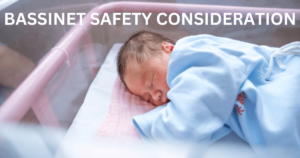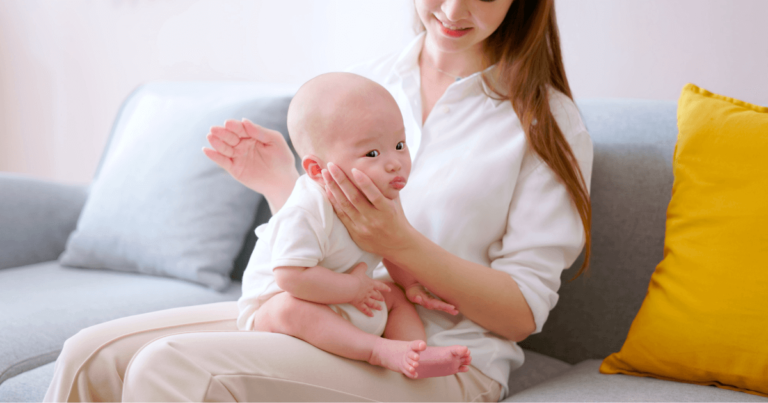How To Get Newborn To Sleep in Bassinet

Are you wondering how to get newborn to sleep in bassinet? Don’t worry, you’re not alone! Many new parents struggle with getting their newborn to sleep in a bassinet. In this guide, we’ll discuss some tips and tricks that can help your baby sleep comfortably in their bassinet.
What is a bassinet?
A bassinet is a small, portable bed specifically designed for newborns and young infants. It’s typically smaller than a crib and has a hood or canopy to provide a cozy and secure sleeping environment for the baby.
You May Like: The Ultimate Guide to Swaddling
Causes- Why baby won’t sleep in bassinet
Before we dive into tips and tricks, it’s important to understand why your baby may not be sleeping in their bassinet. Some common reasons include:
- Feeling gassy: Newborns are still developing their digestive system, which can cause discomfort and gas buildup. This can make it difficult for them to fall asleep in a flat position. With this kind of discomfort, it’s no surprise that your baby may have a hard time sleeping in a bassinet.
- Startle reflex: Newborns have a natural startle reflex, also known as the Moro reflex. This means that they may suddenly wake up and flail their arms and legs, which can be alarming for them when sleeping in a bassinet.
- Hunger: Newborns have small stomachs and need to eat frequently, especially in the first few weeks. If your baby is hungry, they may wake up often and have a hard time falling back asleep in their bassinet.
- Need for physical contact: During pregnancy, babies are used to being constantly held and snuggled by their mother’s womb. After birth, this can result in a strong desire for physical contact with their caregivers, making it difficult for them to sleep alone in a bassinet.
- Temperatures: Babies can be sensitive to changes in temperature, and if they feel too hot or cold, they may struggle to sleep in their bassinet. Newborn are sensitive to temperature changes and may find it difficult to settle in a bassinet if they are too hot or cold.
- Light and noise: Babies are used to the constant sounds and darkness of their mother’s womb. If their sleep environment is too bright or noisy, it can be challenging for them to fall asleep in a bassinet.
- Dirty diaper: A soiled diaper can cause discomfort and disrupt your baby’s sleep. Babies will be always uncomfortable when they have a dirty diaper and this can make it difficult for them to sleep in a bassinet.
- Developmental changes: As babies grow and develop, their sleep patterns also change. This may result in them having a harder time sleeping in a bassinet as they get older and need more space and movement while sleeping.
Don’t Miss: How to burp a baby
Solution- How will i get my baby to sleep in a bassinet?
There are several strategies you can try to help your baby sleep in a bassinet:

- Swaddling: Wrapping your baby snugly in a swaddle blanket can mimic the feeling of being held and provide a sense of security, helping them settle into the bassinet. The right way to swaddle your baby is by making sure their arms and legs are snug, but not too tight.
- White noise: Using white noise, such as a sound machine or a fan, can help drown out any sudden noises that may disrupt your baby’s sleep. It can also create a soothing environment that mimics the sounds of the womb.
- Warm up the bassinet: Before placing your baby in the bassinet, warm it up by using a hot water bottle or heating pad for a few minutes. This will make it more comfortable for your baby and mimic the warmth of being held.
- Familiarize your baby with the bassinet: Allow your baby to spend some time in the bassinet during playtime or while they are awake. This will help them get used to the space and associate it with positive experiences.
- Gradual transition: If your baby is used to sleeping in a co-sleeper or your bed, it may take time for them to adjust to sleeping in a bassinet. You can try gradually transitioning them by starting with naps in the bassinet before moving on to nighttime sleep.
- Establish a bedtime routine: A consistent bedtime routine can help signal to your baby that it’s time to sleep. This can include activities such as a warm bath, feeding, reading a bedtime story, and dimming the lights.
- Patience: It may take some patience and persistence for your baby to get used to sleeping in a bassinet. Be patient with them and continue trying different strategies until you find what works best for your little one.
Read Also: Newborn Routines Made Simple
Safety consideration when using a bassinet
When using a bassinet for your baby, it is important to also consider safety measures to ensure their well-being. Some key safety considerations include:

- Firm and flat surface: The mattress in the bassinet should be firm and flat, with no gaps or spaces that could potentially cause suffocation. Always follow the manufacturer’s instructions for the proper use of the bassinet.
- Proper positioning: Place your baby on their back in the bassinet to reduce the risk of SIDS (Sudden Infant Death Syndrome). This is also a recommended sleep position by pediatricians.
- No loose bedding or objects: Keep the bassinet free of any loose bedding, pillows, blankets, or stuffed animals that could potentially suffocate your baby. It should be a clutter-free and safe sleeping environment.
- Weight limit: Always check the weight limit of your bassinet and make sure your baby does not exceed it. If they do, it’s time to transition them to a crib.
- Keep the bassinet close by: It is recommended to keep the bassinet in the same room as you for the first six months to a year, or until your baby can roll over on their own. This makes it easier for night feeds and monitoring your baby’s breathing.
- Regularly check for wear and tear: Make sure to regularly check the bassinet for any signs of wear and tear, such as loose screws or tears in the fabric. If anything seems unsafe, discontinue use immediately.
You May Like: How to Choose a Baby Name That Grows with Your Child
Why babies should sleep in a bassinet
According to the American Academy of Pediatrics, babies should sleep in their own safe sleeping space for the first six months to a year. Here are the reasons;
- Reduced risk of SIDS: Placing your baby on their back to sleep in a bassinet reduces the risk of Sudden Infant Death Syndrome (SIDS). This is because babies sleeping on their tummies or sides are more likely to suffocate.
- Convenient for night feeds: Having your baby sleep in a bassinet close by makes it easier for you to attend to them during night feeds. You don’t have to walk far or even leave the room, making it less disruptive for both you and your baby’s sleep.
- Safe and secure environment: A properly set up bassinet provides a safe and secure environment for your baby to sleep in. It helps prevent accidental suffocation and reduces the risk of other hazards such as falls.
- Promotes bonding: Having your baby sleep close by also promotes bonding between you and your baby. You can easily soothe them if they wake up, and being nearby helps strengthen the parent-child bond.
- Easy to transport: Bassinets are usually lightweight and portable, making it easy to move around the house or even take with you when traveling. This allows your baby to have a familiar sleeping space wherever you go.
- Transition from co-sleeping: If you plan on co-sleeping with your baby, a bassinet can be a great way to transition them to their own sleeping space. It provides a similar sense of security and closeness as co-sleeping while also promoting safe sleep practices.
- Can aid in reflux or congestion: Some bassinets come with adjustable incline options, which can help babies who have reflux or congestion by elevating their head while they sleep.
Don’t Miss: Choosing the Perfect Baby Name
Best Bassinet To Buy For Your Baby (Amazon)
- BabyBond Baby Bassinet Bedside Crib
- Bassinet Bedside Sleeper
- Bedside Crib for Baby
- Karley Bassinet in Onyx
- Baby Basinet Bedside Sleeper
- Cowiewie 3 in 1 Baby Bassinet
- Ezebaby Baby Bassinet
- ANGELBLISS 3 in 1 Baby Bassinet
- ADOVEL Baby Bassinet Bedside Crib
Final Thoughts
Overall, using a bassinet for your baby’s sleep not only promotes safe sleep practices but also offers numerous benefits for both the baby and parents. However, always make sure to follow safe sleep guidelines and recommendations from pediatricians to ensure your baby’s safety and well-being. It is important to choose a bassinet that meets safety standards, has a firm mattress, and is used according to the manufacturer’s instructions.
Related Articles
Boy Names That Start With A and End With Letter A






